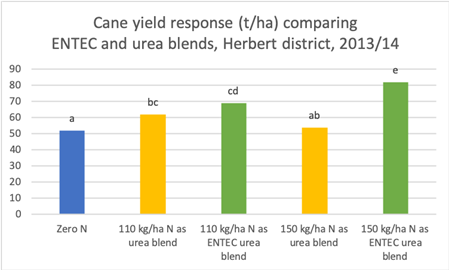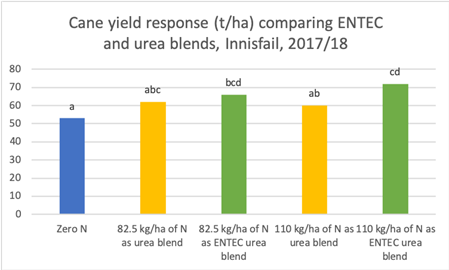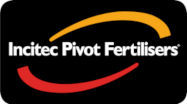Using ENTEC in dry seasons
This year, early ratoon growth in many cane growing districts has been slow due to a combination of dry conditions and cool overnight temperatures, even in the north. This has put fertiliser programs behind schedule. The dry weather has also meant that growers and their advisers have not been thinking about the risk of nitrogen losses from leaching, denitrification or runoff. This is a case of “out of sight, out of mind”. But actually, ENTEC has a good record of success when applied in the dry. That’s because it doesn’t stay dry forever.
Click here to download this article
How long ENTEC remains active in the soil depends on biological activity. When soils are dry, ENTEC remains active for longer. This means ENTEC is likely to still be actively inhibiting the nitrification of applied fertilisers even after a few months of dry weather. This is particularly relevant this season, with the Bureau of Meteorology predicting a delayed start to the monsoon, related to the late retreat (movement south) of the Southwest Indian monsoon.
Often, when there is a dry start to the season like we’ve had this year, the next rain event is a big one. That’s when ENTEC delivers good results for growers, because the nitrogen is stabilised as ammonium and available in the root zone for use when the crop starts growing.
For example, in a replicated small plot trial in the Herbert district in 2013/14, using ENTEC increased cane and sugar yields over a traditional urea blend, even though it was dry for two months after the fertiliser application (Figure 1 and Table 1). It began raining on Boxing Day and then four months later, Cyclone Ita hit, providing another major deluge. At the end of the season, where 150 kg/ha of nitrogen was applied as an ENTEC urea blend, 81.5 t/ha of cane was cut with a sugar yield of 11.2 t/ha. The same rate of nitrogen supplied as a urea blend yielded 53.7 t/ha of cane and a sugar yield of 8.4 t/ha. The losses from the untreated urea blend appear to have been so significant that even applying a higher rate of nitrogen did not improve yield.

Source: Herbert Sustainable Farming Systems group, the Queensland government and Herbert Cane Productivity Services Limited. Significant difference shown by letter at P <0.05.
Table 1: Sugar yield response (t/ha) from ENTEC and urea blends, Herbert district, 2013/14
|
Zero N |
110 kg/ha of N as urea blend |
110 kg/ha of N as ENTEC urea blend |
150 kg/ha N as urea blend |
150 kg/ha N as ENTEC urea blend |
|
8.0 (a) |
8.8 (abc) |
11.8 (d) |
8.4 (ab) |
11.2 (d) * |
It was a similar story after another dry start to the season in Innisfail in 2017/2018. In January 2018 there were a few moderate rainfall events. This was 42 days after the fertiliser was applied. However, it was much later (77 days after fertiliser application) that the first significant rainfall event occurred (170 mm in February 2018).
Using an ENTEC urea blend provided statistically significant increases in cane and sugar yields compared with an untreated urea blend, based on the Six Easy Steps nitrogen rate of 110 kg/ha (Figure 2 and Table 2). The ENTEC treatment at 110 kg/ha of nitrogen yielded 72 t/ha of cane and 12.2 t/ha of sugar. The untreated urea blend at the same rate yielded 60 t/ha cane and 10.4 t/ha of sugar. ENTEC was able to deliver yield increases of 20% (t/ha of cane) and 17% (t/ha of sugar) respectively.


Table 2: Sugar yield response (t/ha) from ENTEC and urea, Innisfail, 2017/18
|
Zero N |
82.5 kg/ha of N as urea blend |
82.5 kg/ha of N as ENTEC urea blend |
110 kg/ha N as urea blend |
110 kg/ha N as ENTEC urea blend |
|
9.0 (a) |
10.5 (abc) |
11.2 (bcd) |
10.4 (ab) |
12.2 (cd) |
ENTEC is typically active across all of the unpredictable seasonal conditions cane growers face. Where agricultural soils have a pH(w) of more than 4.51, Nitrogen fertilisers are better protected from leaching, denitrification and runoff with ENTEC.
If the fertilisers are incorporated into the soil with 10 cm of compacted soil coverage, the nitrogen is also protected against volatilisation losses. Consider incorporation with a StoolZippa® as a means of more consistently achieving the required compacted soil cover. Managing volatilisation is the first step towards achieving the best potential from ENTEC use. Additionally, the StoolZippa can reduce losses of nitrogen from runoff.
Considering the current sugar price2, growers need to optimise potential yields through better nitrogen use efficiency. Every tonne matters. At current prices, growing one extra tonne of cane/ha could cover the price difference between using urea or ENTEC urea.3
For more information about using ENTEC this season, feel free to give me a call to discuss on 0428 111 471 or email me on rob.dwyer@incitecpivot.com.au.
References:
1 Dwyer R, "Understanding ENTEC in a sugar cane system" (2019)
https://www.incitecpivotfertilisers.com.au/news-and-insights/agronomic-insights/sugar/understanding-entec-in-a-sugar-cane-system
2 Queensland Sugar Limited (QSL) daily price on 31 October 2019 of $393.88/t
https://www.qsl.com.au/sugar-prices
3 Assumes the daily price from 31 October 2019 of $393.88/t (as above) and a minimum CCS of 10%. Current average CCS is 14.07% (Australian Sugar Milling Council 27 October 2019). Assuming an application of 150 kg/ha of urea, the additional spend on ENTEC is $39/ha.
®ENTEC is a registered trademark of EuroChem Agro GmbH. ®StoolZippa is a registered trademark of EHS Manufacturing Pty Ltd.This is a guide only, which we hope you find useful as a general tool. While Incitec Pivot Fertilisers has taken all reasonable care in the preparation of this guide, it should not be relied on as a substitute for tailored professional advice and Incitec Pivot Fertilisers accepts no liability in connection with this guide.



